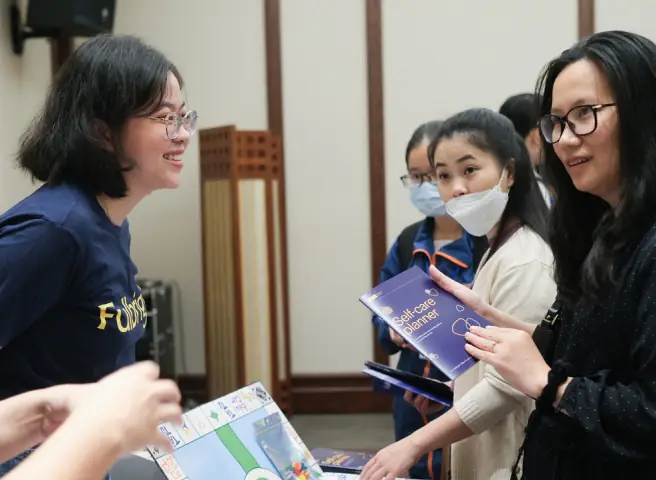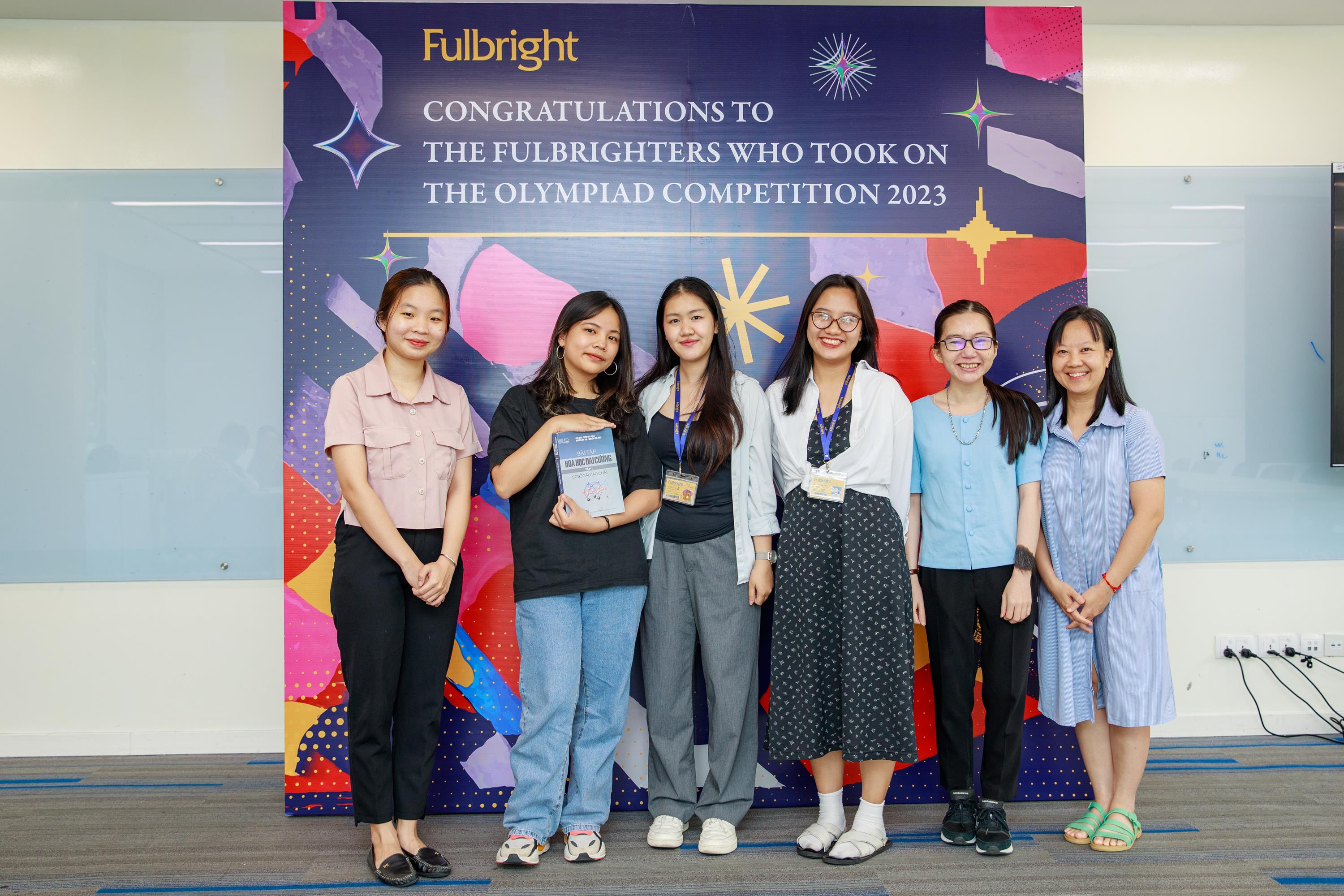
Fulbright University Vietnam recently held a conference on “Nguyen Du and Contemporaries” to commemorate the 200th anniversary of the great poet’s passing. The event was attended by close to 200 participants, including high school and university students. The conference was a chance for lovers of poetry and literary researchers alike to commemorate Nguyen Du, reflecting on his most famous, most invaluable work: Truyện Kiều (The Tale of Kieu).
The miraculous vitality of The Tale of Kieu
What makes “The Tale of Kieu” different from other literary masterpieces in Vietnam is its universal qualities, and a pervasive vitality. Since its first publication, the epic poem rose to fame, and not just inside Vietnam. It was translated to French in 1884, and into many other languages soon after.

Writer, researcher Nhat Chieu (right)
According to Nhat Chieu, writer, translator and literary researcher, the world is now familiar with the “The Tale of Kieu” through translated versions in more than 20 languages, counting over 10 acclaimed translations each in English and French alone.
The Tale of Kieu is ranked among 10 literary masterpieces outside Europe, along with India’s Ramayana, Japan’s Tale of Genji and Li Bai’s poems from China.
“When I read the translated versions, as well as the books and articles published by foreign scholars on The Tale of Kieu, I can feel their serious dedication to the work, their heartfelt enthusiasm towards this literary masterpiece. They have offered a multitude of unique perspectives. This is how I’ve realized that Nguyen Du created a character that can live on forever in the hearts of readers all over the world,” writer Nhat Chieu said at the conference.
Nhat Chieu also quoted a foreign researcher, saying, “when we follow the life story of the main character, Kieu, we see the entirety of Vietnam as a country, steeped in a past of grim tragedies. Viet[nam] sounds like “vuot”, which means “pass”. Vietnam, as a country has passed through a long journey of tribulations, just like Kieu.” Meanwhile, another researcher had said The Tale of Kieu reminded him of the legend of Trong Thuy and Mi Chau, helping them understand how a Vietnamese woman could be so passionate and wholeheartedly dedicated in love.

A self-reflection
When attempting to answer the question of The Tale of Kieu’s universality, a common response is that people can see parts of themselves in The Tale of Kieu, whether it is the mood, the personality, the plight, the fate, or the desires portrayed. Ha Van Thach, a Kieu researcher and former deputy chairman of Ha Tinh Province People’s Committee, explained that The Tale of Kieu successfully explores the deepest mysteries of the human heart, thus helping people understand themselves, others, and their country.

Mr. Ha Van Thach
“Many scholars have remarked that Nguyen Du’s talent lies in successfully portraying the human heart and mind, illuminating the deeper truths, the good and the bad. This is the hardest thing to accomplish, as an old saying would tell us: “Tri nhân tri diện bất tri tâm” (“When an artist paints a tiger, he can only paint it skin, not his bones. When we observe people, we can only know their appearance, not their truest intentions”). In The Tale of Kieu, Nguyen Du writes in order to know a person, from their appearance to their intentions. The Tale of Kieu is like a mirror for people to see the hidden secrets, the bright and the dark sides of themselves,” Mr. Thach said at the conference.
Nhat Chieu further praised the intemporal vitality of The Tale of Kieu, attributing it to its openness. Similarly to Lord Byron’s Don Juan and Alexander Pushkin’s Eugene Onegin, two literary classics of the 19th century, the researcher explains The Tale of Kieu has to be interpreted through the lens of the “lyrical self” – a means to distinguish between the poetic form of the lyrical subject, and the empirical person of the author. Both Byron and Pushkin use their characters to explore their self, just like Nguyen Du who was not in fact writing about a random girl living during the reign of the Jiajing Emperor in Ming China. Instead, he wrote about himself. The expression “Trăm năm trong cõi người ta” in Vietnamese is a phrase that means the hundred-year span of a human life. It is implicitly accompanied by its very close counterpart “Trăm năm trong cả người tôi”, a clever substitution that shifts meaning to “a hundred years in all of me.” Writing about Kieu therefore functions as a way to write about the author’s experience, and the pain and suffering of others who like him lived through times of chaos and dramatic changes.
“It is necessary to add new meanings to a classic work, and the greatness of a literary work lies in the openness of it. In the 19th century literature, The Tale of Kieu stands out for the lyrical self of Nguyen Du as he portrays human life in chaotic times. New generations of readers read The Tale of Kieu today and find new meanings for themselves, not just in the story of Kieu set in the period that Nguyen Du experienced,” writer Nhat Chieu explained.
The Tale of Kieu in diplomacy
Ben Wilkinson, Executive Director of Trust for University Innovation in Vietnam, shared with the participants of the conference some experiences he had when preparing the speeches for American politicians during their visits to Vietnam. Speech writers like him always tried to find new materials for the speeches to be delivered in the Vietnam-US bilateral meetings. The Tale of Kieu has become a vivid source of inspiration for them to write the speeches, because the Vietnamese masterpiece explores many aspects that can be related to the history of Vietnam-US relations, including tragedies, fate, hope, betrayal and love.

In 2000, during the reception at the Presidential Palace in Hanoi, hosted by then President Tran Duc Luong, US President Bill Clinton – the first US president to visit Vietnam after 25 years after the Vietnam War – delivered his remarks to thank the Vietnamese government for their warm welcome. He quoted two sentences from The Tale of Kieu: “Sen tàn cúc lại nở hoa/Sầu dài ngày ngắn, Đông đà sang Xuân” (Just as the lotus wilts, the daisy blooms forth. Time softens grief, and the winter turn to spring). The lotus is traditionally understood as a symbol of summer. Similarly, the daisy represents fall. By referring to a verse describing cyclical change and renewal, implying that time softens grief, President Bill Clinton offered a message of hope for such renewal to occur between the US and Vietnam, from former foes to closer friends.
In July 2015, during the reception hosted by then US Vice President Joe Biden at the US Department of State, Biden delivered a speech to celebrate the normalization of Vietnam-US ties, and the renewed efforts to heal the aftermath of war, including the search for MIA soldiers or dioxin decontamination. There, he quoted two sentences from The Tale of Kieu: “Trời còn để đến hôm nay/Tan sương đầu ngõ vén mây giữa trời” (Thank heaven we are here today. To see the sun through parting fog and cloud). The verses carried special meaning, a wish for the development of Vietnam-US relations from its troubled past.

Positive messages about the ties between the two countries were also sent by US President Barack Obama when he talked to Vietnamese youths during his visit to Hanoi in 2016. He quoted The Tale of Kieu in his speech, saying: “Rằng trăm năm cũng từ đây. Của tin gọi một chút này làm ghi” (Please take from me this token of trust, So we can embark on our one-hundred-year journey together).
Wilkinson said The Tale of Kieu is much favored and usually quoted by American diplomats to allude to the Vietnam-US relations because it is widely loved by Vietnamese people regardless of their backgrounds.
“Speech writers want to send a meaningful message to Vietnamese people and there is no better choice than to pick such a beloved national literary masterpiece,” he concluded.
Xuan Linh







